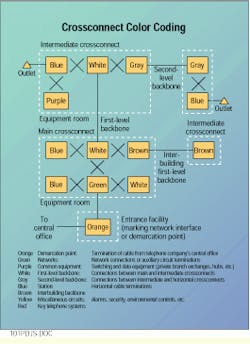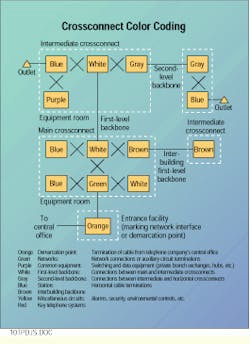Document and color-code your installation
Donald J. Sterling, Jr.
Problem
The TIA/EIA-606 standard for the telecommunications infrastructure of commercial buildings recommends specific guidelines for documenting the premises network structured cabling system. However, some confusion may exist regarding standards-based color-coding in a telecommunications installation.
Solution
When making moves, adds and changes, you must be able to identify cables quickly and accurately. A reliable documentation system is essential to accomplish this, and color-coding the circuits as recommended by TIA/EIA-606 is useful in troubleshooting the cabling plant. Color-coding allows you to identify cables quickly, easily double-check your work and reduce wiring errors.
Documentation records
Follow the TIA/EIA-606 standard record scheme, which breaks a record into four types of information:
- Required information -- This is the essential information about the component. For a cable, it includes the type -- for example, unshielded twisted-pair Category 5, 62.5/125-micron fiber --unterminated pairs, damaged pairs and available pairs.
- Required linkages -- Linkages are pointers to other records. For a cable, it includes termination records that show where and how the cable is terminated, and pathway records that indicate where and how the cable is routed.
- Optional information -- This includes any additional information you may want, to make the record as complete and comprehensive as you require. It can include cable length, product code or manufacturer`s part number, and test information.
- Optional linkages -- These point to additional records that might be helpful to include. For example, if a cable attaches to a network hub or workstation, you might want to include a linkage to the record for the device.
Procedure for color-coding
1) TIA/EIA-606 recommends color-coding only for crossconnects within the cabling system.
2) Your color-coding scheme does not have to be limited to those recommended in the TIA/EIA-606 standard.
3) You can also color-code by cable performance level, so that a Category 3 connection is easily distinguished from a Category 5 connection.
4) Although the standard is intended for crossconnects, you can extend it to other parts of the building. For example, blue is recommended for the telecommunications closet, but not for the outlet in the workstation area. Color-coding an outlet for telephones and low- and high-speed network connections, however, can help identify ports as well as icons and words.
Crossconnect color-coding recommended by the TIA/EIA-606 standard.
This tip is excerpted and reproduced by permission from Premises Cabling by Donald J. Sterling, Jr., and published by Delmar Publishers, Albany, NY (see "By the Book," May 1996, page 67).
This is by no means a complete version of the TIA/EIA-606 Administration Standard for the Telecommunications Infrastructure of Commercial Buildings. For the complete TIA/EIA-606 standard, call Global Engineering Documents at (800) 854-7179.

